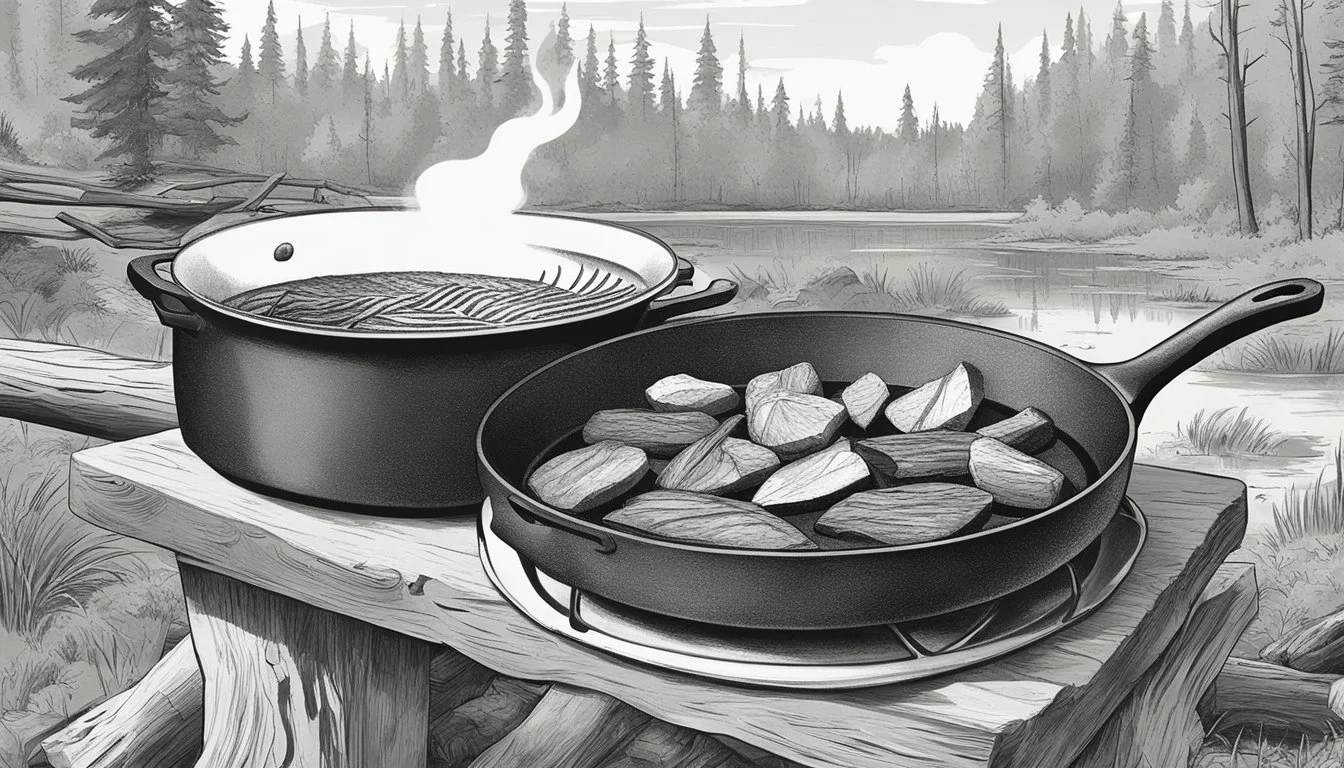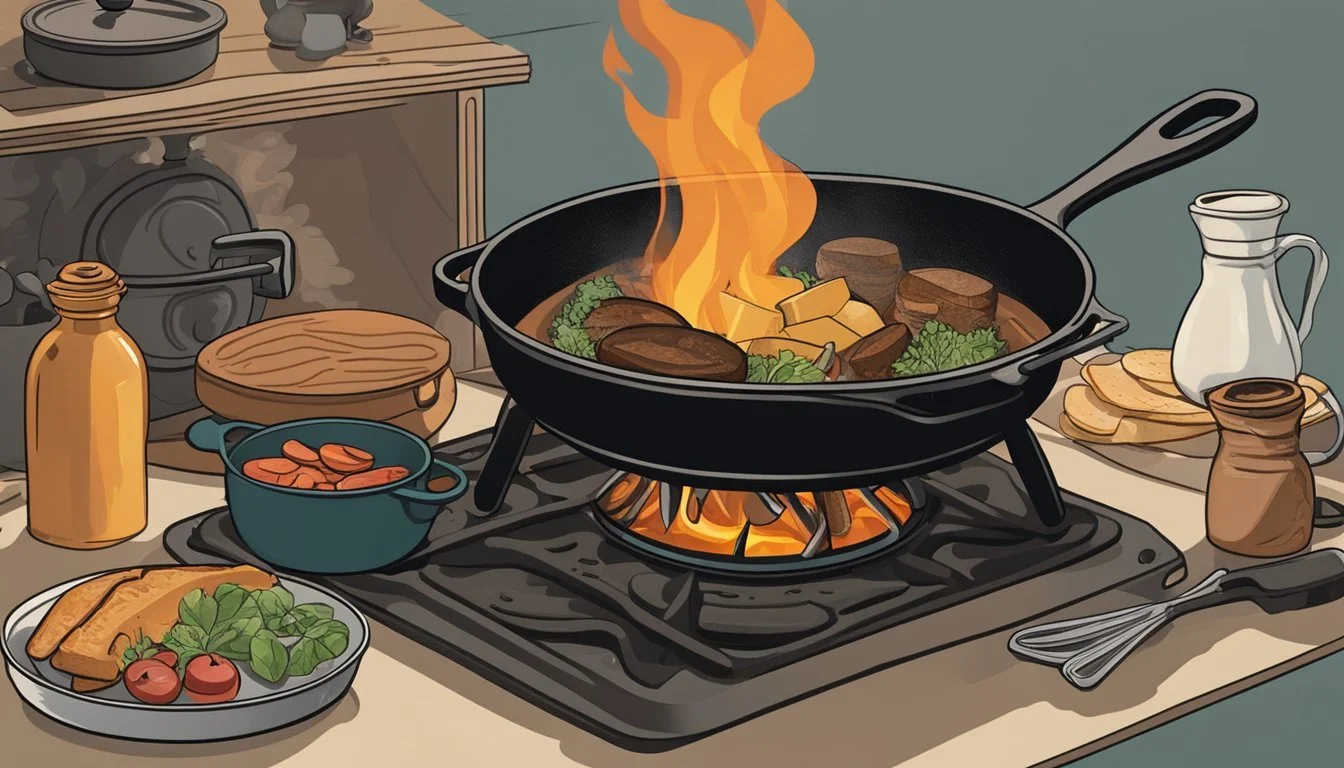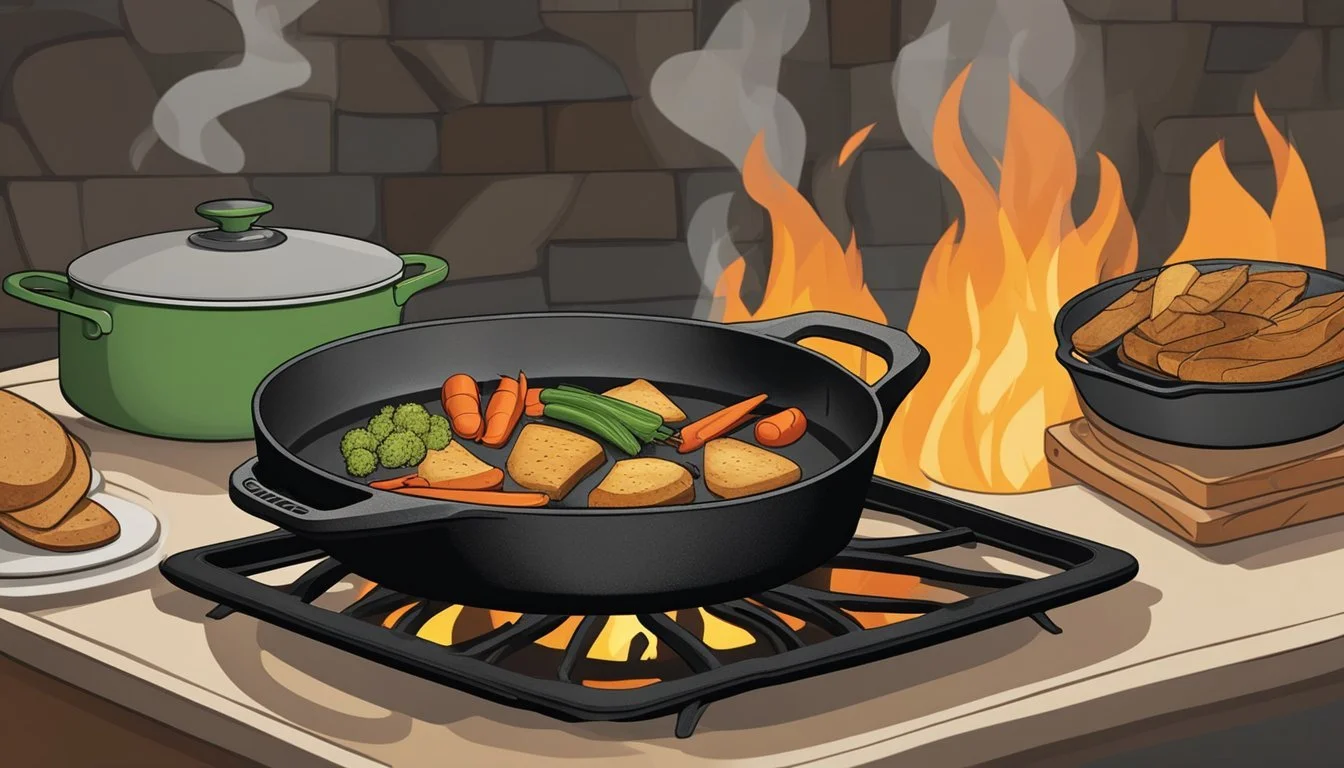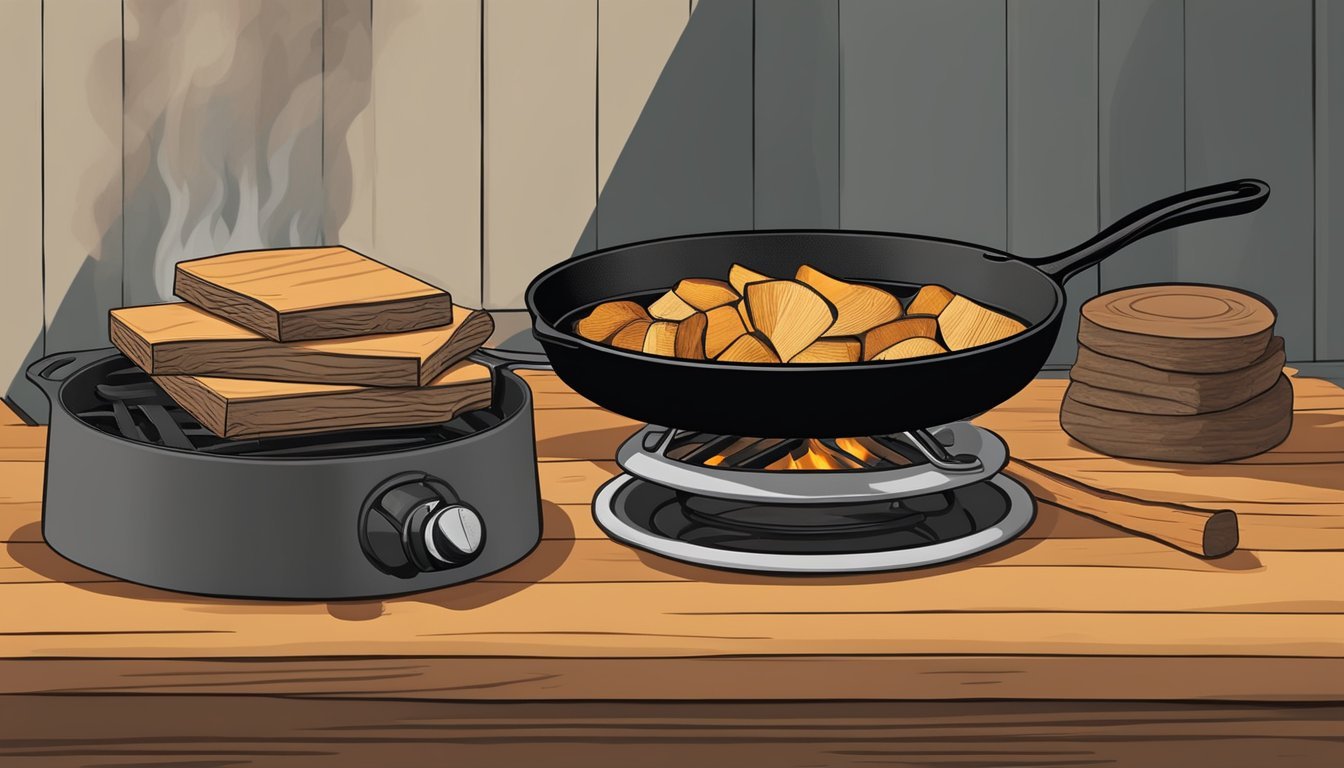The Versatility of Cast Iron
Unmatched Cooking Flexibility for Home and Outdoor Use
Cast iron cookware is a testament to the saying "old is gold," holding a prized position in kitchens and campsites alike. This culinary workhorse is beloved for its durability and excellent heat retention, capable of withstanding and thriving under the intense heat of both a stovetop and a raging campfire. Its rugged charm and endless utility have solidified cast iron's status in the cookery realm, where it navigates the demands of various cooking techniques, from searing steaks to baking fluffy cornbread.
The true allure of cast iron lies in its inherent versatility. Equipped to handle a myriad of cooking tasks, it offers an equally stellar performance across different heat sources. Whether it's nestled into the coals of a campfire or gracing the burners of a modern gas range, cast iron delivers consistent heat that deeply flavors and perfectly textures a vast array of dishes. Its ability to go from stovetop to oven or from kitchen to campsite without missing a beat makes it an indispensable tool for both home chefs and outdoor adventurers.
Cast iron cookware is celebrated for its exceptional versatility, offering a wide range of culinary and decorative possibilities. Beyond its functionality in the kitchen, cast iron pieces can serve as charming cast iron decor, adding a touch of rustic elegance to any home. Their timeless appeal and durability make them a popular choice for both cooking and display.
When it comes to maintenance, cleaning cast iron is essential to ensure the longevity and non-stick properties of the cookware, preserving its versatility for years to come. Additionally, cast iron's ability to retain and distribute heat evenly makes it ideal for various cooking techniques, including batch cooking and the creation of cost-effective and delightful cast iron budget recipes.
The versatility of cast iron extends to accommodating different dietary needs, such as the creation of delicious gluten-free cast iron baking. Furthermore, for enthusiasts, cast iron collectibles offer a unique way to appreciate the history and craftsmanship of these beloved kitchen essentials.
With its wide range of applications, from meal prep to decorative display, cast iron's versatility makes it a cherished and enduring choice for home cooks and collectors alike.
Historical Significance of Cast Iron Cookware
In tracing the journey of cast iron cookware, one discovers its resilient legacy and its impact on culinary practices through the ages. This durable material has withstood the testament of time from ancient origins to becoming a cultural staple.
Origin and Evolution
Cast iron's story begins around the 5th century BC in China, where it was first created for a variety of uses, including cookware. This innovation was pivotal as it allowed the creation of sturdy and heat-retentive cooking vessels. The material's prominence spread, and by the 20th century, numerous American foundries were manufacturing cast iron cookware. Notably, names like Griswold and Wagner Ware symbolized quality craftsmanship. However, the introduction of new materials in the 1900s led to a decline in cast iron's popularity until it experienced a revival in recent decades.
Popularity and Cultural Impact
Cast iron cookware gained momentum in the 1970s but saw a decline due to the rise of non-stick surfaces which made cooking and cleaning more convenient. Despite this, in recent years, there has been a resurgence of interest in cast iron for its unparalleled durability and versatility in cooking. It's now praised for its ability to maintain high temperatures and create a natural non-stick surface when properly seasoned. Cast iron pieces are cherished heirlooms in many households, indicative of the material's lasting relevance in both restaurants and home kitchens.
The Science of Cast Iron
Cast iron's utility in the kitchen is largely due to its material properties and superior ability to retain and distribute heat.
Material Properties
Cast iron cookware boasts remarkable durability due to its high carbon content, which contributes to its robustness and resistance to wear. This material is formed by casting iron into molds, creating a piece that can withstand many years of culinary challenges. It can endure high temperatures, making it suitable for various cooking environments.
Heat Retention and Distribution
One of the essential characteristics of cast iron is its heat retention. Once the pan heats up, it stays hot, which is ideal for keeping food warm after it's removed from the heat source. Additionally, cast iron offers even heat distribution, ensuring a uniform cooking temperature across the entire surface. This is particularly beneficial when searing meat or baking bread, where consistent coverage is desired.
Seasoning and Care
Proper care enhances the non-stick qualities of cast iron and imbues food with rich flavors, while also preventing rusting. Correct seasoning and maintenance ensure a long life for these versatile kitchen staples.
Practical Guide to Seasoning
Seasoning a cast iron skillet involves coating it with a thin layer of oil and heating it to create a non-stick surface. The process begins by washing the skillet and drying it thoroughly to prevent rust. A suitable oil, like vegetable oil, is then applied sparingly across the cooking surface. The skillet should be placed upside down in an oven preheated to around 500°F or heated on a stove over medium heat for about 10 to 15 minutes until the oil polymerizes, forming a protective layer.
Materials Needed:
Mild soap
Sponge or dishcloth
Dry kitchen towel
Vegetable oil or shortening
Oven or stovetop
Steps:
Wash and dry the skillet.
Apply oil evenly, wiping off excess.
Heat as directed to form a seasoning layer.
Maintenance and Cleaning Methods
Immediately after use, a cast iron skillet should be cleaned to maintain its condition. For day-to-day cleaning, hot water and a non-abrasive sponge suffice, avoiding harsh soaps that can strip the seasoning. For tougher residue, a paste of coarse kosher salt and water can be used to scrub the pan gently. After washing, the pan should be dried completely with a towel and heated on the stove for a few minutes to evaporate any remaining moisture. It's beneficial to apply a light layer of oil after cleaning to preserve the non-stick surface.
Cleaning Tools:
Non-abrasive sponge
Coarse kosher salt (for tough residue)
Clean, dry towel
Cleaning Steps:
Rinse with hot water; scrub if necessary.
Dry thoroughly using a towel.
Heat to remove leftover moisture.
Apply a light coat of oil to protect seasoning.
Preventing Rusting and Damage
To prevent rust, one must keep the cast iron dry and properly oiled. Storage in a cool, dry place prevents moisture buildup. If rust does appear, it can be removed by scrubbing with steel wool followed by reseasoning. Protect the cookware from sudden temperature changes to avoid cracking. When cooking acidic foods, limit the duration to preserve the seasoned layer.
Prevention Tips:
Store in a dry environment.
Avoid leaving water in or on the skillet.
Treat any rust spots immediately.
When Cooking:
Use moderate heat to avoid damage.
Minimize cooking time for acidic foods.
Employ these care routines to ensure the cast iron's durability and enjoy its full range of cooking possibilities.
Cooking Techniques and Uses
Cast iron cookware excels in versatility, from stovetop griddling to oven baking and campfire cooking, making it ideal for a wide range of dishes.
Stovetop Mastery
Utilizing a cast iron skillet or griddle on a stovetop allows for even heat distribution, which is essential for cooking pancakes to golden perfection or searing a steak with a deliciously caramelized crust. For stews, the ability of cast iron to maintain consistent heat makes it perfect for simmering ingredients over a prolonged period, enriching flavors and tenderizing meats.
Stews: Slow simmer on low to medium heat to enhance flavors.
Pancakes: Cook on medium heat until bubbles form, then flip.
Oven Baking and Roasting
When using cast iron in the oven, its superior heat retention ensures baked goods like skillet cornbread have a uniformly crisp edge, while its heat resilience allows it to roast meats evenly without warping. The versatility extends to Dutch ovens, which are perfect for no-knead bread, as the enclosed space provides the steam necessary for a crispy crust.
Skillet Cornbread:
Preheat the skillet in the oven for a crispy crust.
Bake at 425°F (218°C) until golden brown.
Campfire Cooking Essentials
Cast iron's durability makes it the cookware of choice for campfire cooking. A skillet or Dutch oven can withstand the direct heat of an open fire, making them indispensable for outdoor culinary ventures. Whether it's skillet-frying fish beside the river or slow-cooking a hearty Dutch oven chili under the stars, cast iron consistently delivers.
Open Fire Cooking:
Skillet: Great for frying or sautéing directly over the campfire.
Dutch Oven: Ideal for slow-cooked meals that benefit from even heat.
Types of Cast Iron Cookware
The variety of cast iron cookware available today allows for a broad range of cooking techniques from searing to baking and even outdoor grilling. Each type is designed for specific cooking methods to enhance the culinary experience.
Skillets and Griddles
Cast iron skillets are a staple in many kitchens, renowned for their heat retention and even cooking. Skillets often come in various sizes, ranging from small pans suitable for individual servings to large ones fit for family meals. The surface can be either smooth or ridged, the latter being ideal for grilling. Griddles, on the other hand, present a wide and flat cooking area, making them perfect for frying bacon, cooking pancakes or searing a large batch of food. They are typically designed in rectangular shapes, but circular variations are also common, usually featuring a slight edge to contain food and juices.
Dutch Ovens and Camp Pots
Dutch ovens are versatile, deep pots that can go from stovetop to oven with ease. They serve excellently for slow-cooking, stewing, and even baking bread. Dutch ovens can be plain cast iron or enameled cast iron, which features a vitreous enamel glaze to protect the iron against rust and to eliminate the need for seasoning. Camp pots resemble Dutch ovens but are specifically designed for campfire cooking, often sporting legs and a flange lid to hold coals, making them suitable for outdoor cooking adventures.
Specialty Cast Iron Items
Beyond skillets and Dutch ovens, a myriad of specialty cast iron pans exist for specific culinary tasks. These include pizza baking pans, specially designed for creating a crisp crust, or griddle pans with sections tailored for cooking both meat and eggs simultaneously. Specialty items exude the same high-quality heat distribution and retention properties characteristic of conventional cast iron cookery, only with added features to suit particular recipes or cooking styles.
Campfire and Outdoor Cooking
Cooking outdoors with cast iron utilizes the durability and heat distribution properties of the cookware. Whether over a campfire or coals, the correct setup and tools can enhance the outdoor cooking experience.
Setting Up a Campfire for Cooking
When preparing a campfire for cooking, one should select a safe, level spot away from overhanging branches. A fire pit often provides a controlled environment. For fuel, hardwoods like oak or hickory are ideal for long-lasting heat and can be supplemented with charcoal briquettes for a more consistent temperature.
Fire Base: Begin with tinder and kindling, adding larger pieces of wood once the fire is established.
Heat Zones: Create separate heat zones by moving coals to one side for direct and indirect cooking.
Cooking Over Coals and Open Flame
Cooking directly over an open flame can be ideal for grilling, while coals provide a steadier, more even heat source.
Over Coals:
Even Heating: Dense charcoal retains heat for consistent cooking temperatures.
Control: Cooking over coals allows for greater control to avoid burning.
Open Flame:
High Heat: Ideal for quick-cooking items like skewers or for imparting a smoky flavor.
Visibility: Monitor the flame to prevent flare-ups from burning the food.
Tools and Accessories for Campfire Cooking
A few essential tools and accessories can make campfire cooking with cast iron more effective:
Cast Iron Skillet: Retains heat and provides a non-stick surface once well-seasoned.
Cooking Grate: Place over the fire pit to support pots or pans.
Camping Stove: Should you be in an area where open fires are not allowed, a portable camp stove, fueled by gas or charcoal, serves as an efficient alternative.
Comparing Cast Iron with Other Cookware
The following subsections detail how cast iron cookware stands against non-stick, stainless steel, and aluminum and copper counterparts, focusing on attributes like durability and heat distribution.
Cast Iron vs. Non-Stick Pans
Durability:
Cast Iron: Highly durable, can last a lifetime with proper care.
Non-Stick Pans: Less durable; the non-stick coating can wear off over time.
Heat Distribution:
Cast Iron: Heats slowly but retains and distributes heat evenly.
Non-Stick Pans: Typically heats up quickly but heat distribution may be less uniform.
Cast iron skillets require seasoning to maintain their non-stick surface, whereas non-stick pans come with a chemical coating that provides an easy release of food. Non-stick pans are less tolerant to high heat, which can degrade their coating, while cast iron cookware can withstand very high temperatures, making it suitable for stovetop to oven transfers.
Cast Iron vs. Stainless Steel
Durability:
Cast Iron: Extremely durable, not prone to warping.
Stainless Steel: Also durable and resistant to rust and corrosion.
Heat Distribution:
Cast Iron: Offers even heat distribution once heated.
Stainless Steel: With added cores of aluminum or copper, they can heat fast and evenly.
Stainless steel cookware is admired for its non-reactivity and is a more maintenance-free option as compared to cast iron. It does not require seasoning and is usually lighter, making it easier to handle. In contrast, cast iron has the advantage of improving with use and being able to handle abrasive cooking methods, like metal utensils and scouring pads, without damage.
Cast Iron vs. Aluminum and Copper Cookware
Durability:
Cast Iron: Outlasts most cookware with proper maintenance.
Aluminum and Copper: Less durable; dents and warps more easily.
Heat Distribution:
Cast Iron: Retains heat for consistent cooking.
Aluminum: Heats quickly and evenly.
Copper: Excellent heat conductor, allows precise temperature control.
Aluminum and copper are both excellent conductors of heat, which enables these types of cookware to react quickly to temperature changes. However, cast iron's ability to maintain a steady temperature once heated suits it for long-cooking dishes and searing meat. Cast iron also tends to add iron to the food, which can be beneficial in maintaining healthy iron levels. In contrast, aluminum and copper cookware often have to be coated or treated to prevent reaction with acidic foods.
Recipes and Cooking Ideas
Cast iron cookware excels in heat retention and versatility, making it ideal for creating sumptuous meals whether at home or by the campfire. From breakfast to sweets, the following subsections offer a variety of cooking ideas to make the most out of this durable kitchen staple.
Hearty Breakfasts
Pancakes: They are a staple for breakfast; use a well-seasoned cast iron skillet to give them a golden crust. Cook on a pre-heated surface for even heat distribution.
Steak and Eggs: A sizzling steak paired with eggs makes for a protein-rich campfire breakfast. The steak's searing process is enhanced by cast iron's ability to maintain high heat.
Savory Dinners
Grilled Chicken: Season and grill chicken pieces over a bed of hot coals for a smoky flavor. Cast iron's high heat capability allows for a perfectly crispy skin.
Beef Soup: Simmer beef cuts with vegetables and stock directly in a cast iron pot, leveraging its consistent heat for a richly flavored soup.
Pizza: Prepare a campfire pizza by pressing your dough into a cast iron pan, adding toppings, and covering with foil to cook over the fire.
Hot Dogs: For a quick dinner, roast hot dogs on a pie iron over the flames for a fun and easy meal.
Baking and Sweets
Skillet Cornbread: Infuse cornbread with a delectable crust by baking it in a pre-heated cast-iron skillet, ensuring a moist interior and crisp exterior.
Dutch Oven Pie: Use a dutch oven to make pies with your favorite fillings, cooking over an open fire for a rustic dessert experience.
Grilled Cheese Sandwich: Cast iron provides the perfect crunch to a grilled cheese sandwich. Use a pie iron for campfire cooking to seal in the cheese and flavor.
Each of these recipes can be adjusted according to taste preferences and dietary needs, showcasing the flexible nature of cast iron cooking. Whether used on the stovetop or over open flames, cast iron remains an enduring and trusty companion for cooks of all levels.
Maintenance and Storage Tips
Maintaining a cast iron skillet is straightforward, and proper storage is key to ensuring its longevity. By adhering to some basic tips and techniques, one can keep their cookware in prime condition, ready for a variety of cooking environments from the kitchen to the campfire.
Proper Storage Techniques
After cleaning one's cast iron skillet, making sure it’s completely dry is essential to prevent rust. Storing the skillet in a dry, warm place such as a stovetop or an oven—provided it has no wooden parts—is ideal. If one opts to store the skillet in an oven, they must remember to remove it before preheating. Utilizing oven mitts is recommended to handle the cookware, as cast iron retains heat and can become very hot.
Dry Thoroughly: After washing, place it on the stove on low heat to evaporate any moisture.
Avoid Moisture: Store in an area free from humidity.
Accessibility: Keep it within easy reach for frequent use, which helps maintain its seasoning.
Longevity and Sustaining Performance
The durability of cast iron cookware increases with proper maintenance. One should avoid leaving acidic foods in the skillet for extended periods, which can strip the seasoning. If rust spots do appear, a simple scrub with steel wool and a re-seasoning process will restore its performance. Periodic seasoning enhances its non-stick properties and prevents rusting, ensuring it remains a reliable tool for camping cookware and various cooking methods.
Regular Seasoning: Lightly coat with oil and heat in the oven for an hour at 375°F.
Avoid Acidic Foods: Limit exposure to acidic ingredients to maintain the seasoning.
Rust Management: Use steel wool to remove rust, then re-season to restore its condition.
Accessories and Enhancements
In the realm of cast iron cooking, the right accessories can significantly enhance the culinary experience. These tools not only ease the cooking process but also contribute to the longevity and functionality of the cast iron cookware.
Must-Have Cast Iron Accessories
Utensils: To protect the seasoning of cast iron and ensure its durability, one should opt for wooden or silicone utensils. These materials prevent scratches and help maintain the integrity of the cast iron surface.
Lid Lifter: A cast iron lid lifter is an invaluable tool to safely handle hot lids, especially when cooking over an open flame where direct contact with heat is constant.
Fire-Resistant Tongs: When adjusting coals or logs, fire-resistant tongs are crucial. They allow for precise heat control while keeping hands at a safe distance from the flames.
Enhancing the Cooking Experience
Heat Setting: Understanding heat settings is crucial for cast iron cooking. Cast iron distributes heat evenly, making it versatile across various heat sources. Always preheat cast iron to avoid food sticking and to achieve an even cooking temperature.
Cooking Tips:
For optimal heat distribution, select a piece of cast iron cookware that fits the food quantity well, allowing for enough surface contact and proper airflow when necessary.
Timing is key in cast iron cooking. Due to its ability to retain heat, cast iron often requires less cooking time, so monitoring food for doneness is important to prevent overcooking.
Health and Safety Considerations
When using cast iron cookware, one must address health and safety considerations, particularly managing the cookware’s smoke point and ensuring food safety.
Managing Smoke Point and Fumes
The smoke point of an oil is the temperature at which it begins to smoke and break down, possibly producing harmful fumes and free radicals. Cast iron cookware can withstand high temperatures, making it suitable for cooking methods that require searing or frying. To ensure safety and maintain the integrity of the food:
Use high smoke point oils such as canola, avocado, or grapeseed oil when cooking at high temperatures.
Avoid overheating the pan and oil, which can lead to the production of smoke and potentially toxic fumes.
If a recipe requires covering the cookware during the cooking process, one can use aluminum foil as a cover, keeping in mind to not let the foil touch the food directly if it’s acidic, as this could lead to leaching of aluminum into the food.
Food Safety with Cast Iron
Cast iron must be properly seasoned and maintained to prevent rust and ensure a natural, nonstick surface. This seasoning also plays a role in food safety:
Seasoning: An even, well-maintained layer of seasoning prevents food from sticking and reduces the potential for bacterial growth.
Cleaning: After use, one should clean the cast iron cookware with hot water and a brush, avoiding soap which can strip the seasoning. Dry the pan immediately and apply a light coat of oil to protect the surface.
Proper care of cast iron cookware ensures that it remains a safe and non-toxic option for cooking various dishes, from stovetop to campfire.
The Future of Cast Iron Cookware
The evolution of cast iron cookware continues to reflect significant advancements in technology and a deepening understanding of consumer lifestyles. These changes promise enhanced versatility and better integration into modern, eco-conscious living.
Innovations and Trends
Emerging trends in cast iron cookware are focusing on improving the user experience by addressing weight and maintenance concerns. Lightweight designs are becoming more prevalent, catering to those who appreciate cast iron's even heating but desire easier handling. For example, newer models are leveraging innovative techniques to reduce weight without compromising on quality or performance.
Manufacturers are also concentrating on non-stick and rust-resistant technologies to minimize the extensive care traditionally associated with cast iron. These advancements aim to maintain cast iron's versatility, allowing for its use in various cooking environments—from stovetops to campfires—with less upkeep.
Sustainability and Lifestyle
Environmental awareness is shaping the cast iron cookware industry, with sustainability becoming a key factor in production. Recycled materials are increasingly used in manufacturing, reducing the ecological footprint. Additionally, the durable nature of cast iron aligns with a sustainable lifestyle, as its long lifespan lessens the need for frequent replacements.
The trend toward eco-friendly living also intersects with versatility in cookware. Consumers seek out multi-functional products that align with their desire to minimize waste and clutter. Cast iron cookware fits seamlessly into this lifestyle, excelling in a range of cooking scenarios and reducing the need for multiple pots and pans.





